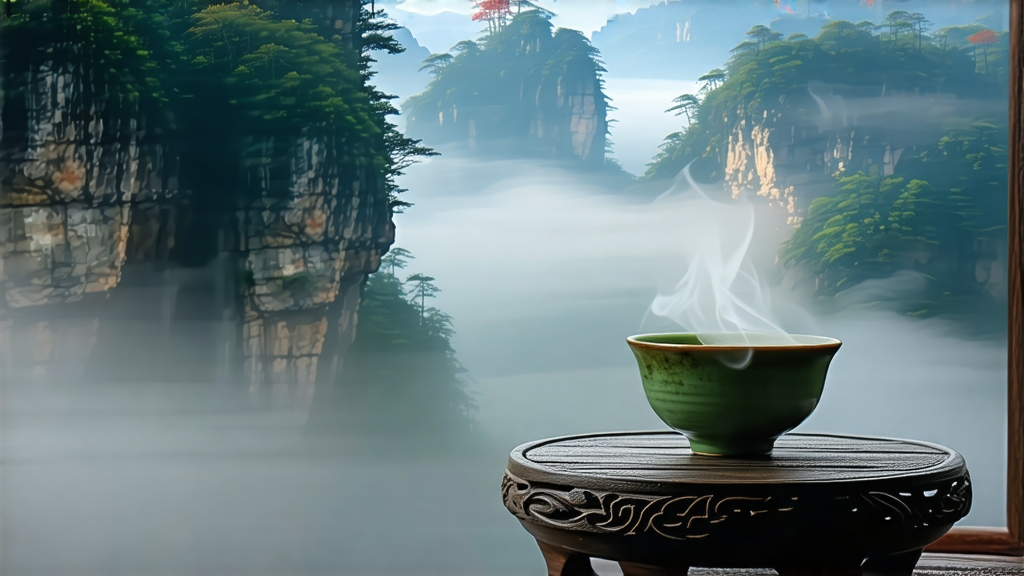
High above the winding Jiuqu Stream, where the Wuyi Range thrusts its granite ribs into the moist Fujian sky, grows the most mythic of all oolong teas—Da Hong Pao, literally “Big Red Robe.” To understand this tea is to step into a tapestry woven from imperial edicts, scholarly pilgrimages, Song-dynasty cliffside monasteries, and the quiet patience of generations whose hands have learned to coax fire, wind, and stone into a single cup of amber liquor. What follows is a complete portrait of that tea: its birth stories, its many faces, the alchemy that turns leaf into poetry, and the ritual that lets you taste the very minerals of the mountain.
-
Myth and Documented History
Folklore speaks of a Ming-dynasty scholar on his way to the capital examinations who collapsed with fever in the Wuyi foothills. Monks from the Tianxin Temple brewed leaves plucked from four stunted bushes clinging to a crack in the cliff; the traveler revived, continued north, and returned months later in the scarlet robe of the newly minted jinshi degree to drape that robe around the bushes in gratitude. Whether or not the crimson silk ever fluttered against granite, court chronicles do confirm that in 1385 the Hongwu Emperor sent a courier to Wuyi with a decree: the six remaining mother trees were henceforth imperial property, their yearly harvest of less than 500 g reserved for the palace altar. For six centuries the trees were guarded by local garrisons; even during the Cultural Revolution, Red Guards posted a wooden sign—half propaganda, half talisman—warning against damage to “proletarian agricultural heritage.” Today those six originals are no longer picked; they stand on a ledge known as Jiulong Ke, “Nine-Dragon Niche,” their gnarled trunks wrapped in red government GPS bands, living monuments rather than commercial resource. Yet the name Da Hong Pao has expanded into a collective appellation for hundreds of hectares of bushes propagated by cuttings, each tracing its DNA to those cliff ancestors. -
Terroir: When Granite Breathes
The Wuyi scenic preserve lies just inside the subtropical circle, but its microclimate is dictated by verticality. Morning fog rises from the stream, condenses on 400-million-year-old igneous rock, and drips back onto shallow, mineral-saturated soils no deeper than twenty centimetres. The stress forces tea roots to spread sideways, absorbing potassium, magnesium, and minute iron particles that later manifest in the cup as yan yun—“rock rhyme,” a tactile aftertaste like wet stone resonating in the throat. Only leaves harvested within the 60 km² core zone may legally bear the designation Zheng Yan, “True Cliff,” the equivalent of Burgundy’s Grand Cru. Outside that halo, Ban Yan (“Half Cliff”) and Zhou Cha (“Peripheral”) teas still qualify as Wuyi oolong but trade some minerality for floral sweetness and a lighter wallet. -
Cultivars: The Red Robe Family Tree
Because Da Hong Pao is a product, not a single plant, the market offers three distinct hierarchies:
• Mother-Tree Cuttings (Chun Qi Da Hong Pao): Direct descendants grafted onto rootstock in the core zone; yield tiny, demand astronomical; liquor shows the most pronounced yan yun and a cooling camphor finish.
• Blended Qi Zhong: A traditional marriage of four Wuyi bushes—Tie Luo Han, Bai Ji Guan, Shui Jin Gui, and the original Da Hong Pao cutting—to recreate complexity when single-garden harvests fall short; the backbone for most serious connoisseur labels.
• Commercial Aromatic Styles: Usually based on the high-aroma Qilan or Rou Gui cultivars, lightly baked to satisfy modern palates that prize orchid top notes over mineral depth; inexpensive entry point but lacking rock rhyme. -
Craft: The Eight-Stage Odyssey
Plucking happens in late April, the two-leaf-and-a-bud standard picked before 10 a.m. while dew still moderates leaf temperature. What follows is a dance between moisture and fire unique to Wuyi: -
Withering: Leaves are spread on bamboo screens set on racks inside a sun-lit corridor; every fifteen minutes a master flips the trays to ensure even water loss.
-
Shaking: The most physically dramatic step—